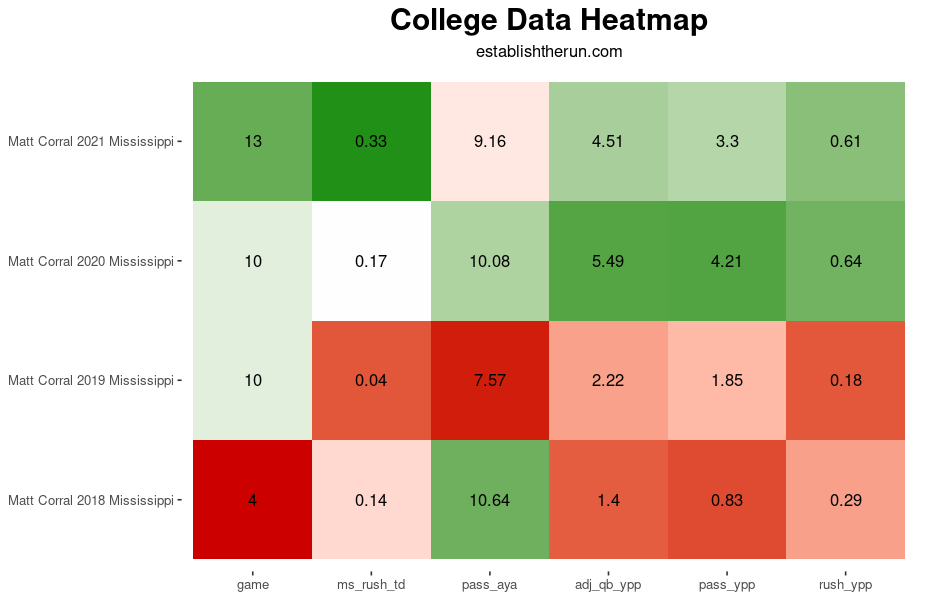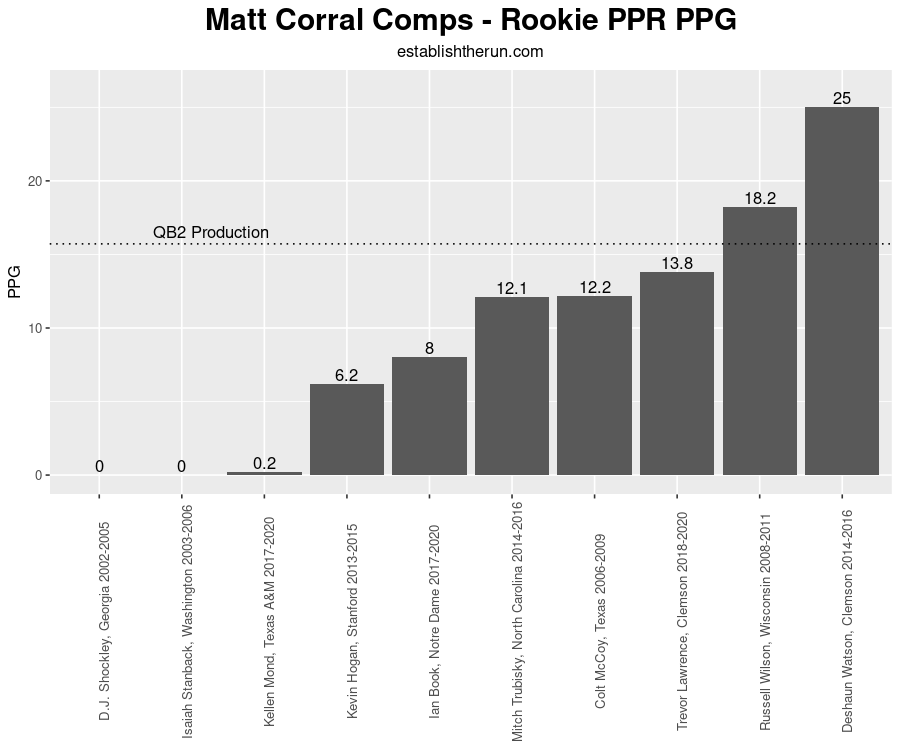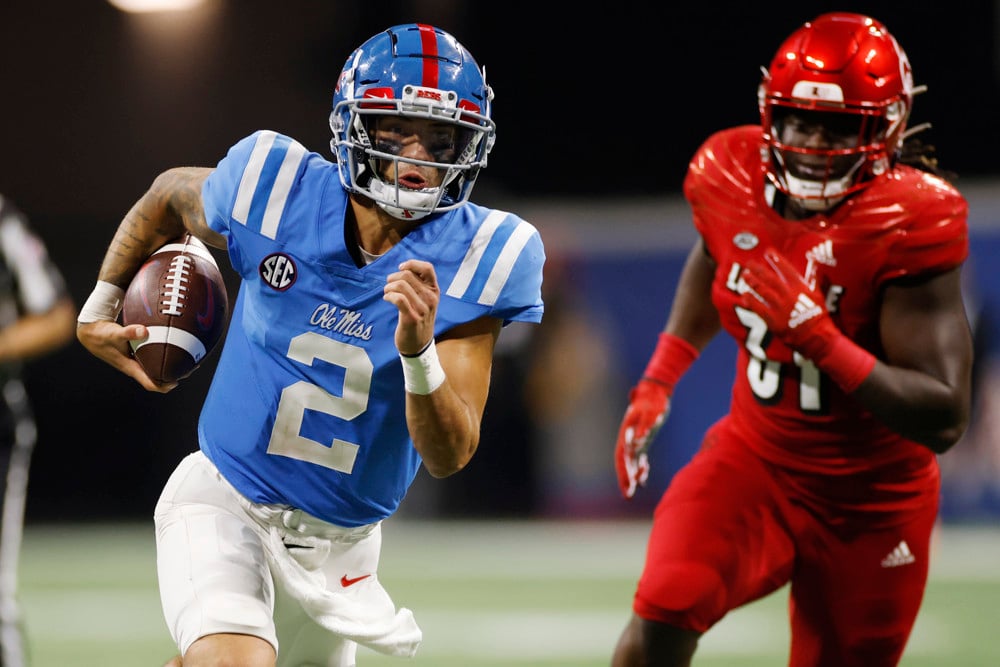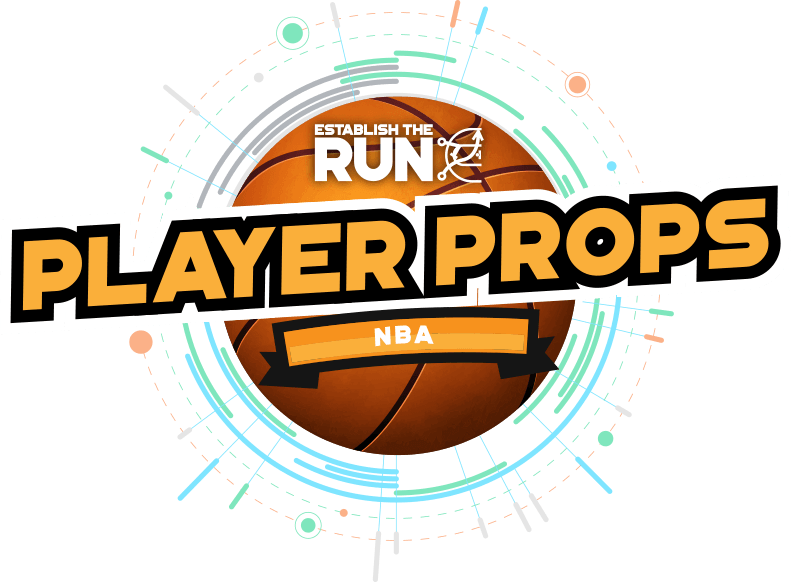Dynasty Outlook
March 24
Matt Corral is currently our QB3 for rookie drafts, and a back-end QB2 in our overall dynasty ranks. His efficiency both as a passer and overall yardage-producer bode well for his future fantasy success, and Corral comps well to a couple of long-term fantasy studs. There are some reasonable concerns here regarding his draft position, age, and playing weight — but they appear to be mostly priced in at this juncture. Corral has sizable upside, and will likely be a first-round target in Superflex rookie drafts as a result.
Profile Summary
Corral was an effective starter his last two seasons at Ole Miss, providing quality two-way production where he was efficient as a passer. One interesting note from the scouts is that the Mississippi offense is considered to be extremely friendly for passers, with a lot of RPOs and well-defined reads. There is an expected learning curve in the NFL, though it does feel as though some of those concepts have also made their way to the pros. Corral comps well to a couple of the game’s best QBs, giving us a glimpse of his upside. His weight will be important to monitor as it relates to his rushing, as Corral tends to take more hits than is necessary, which could lead to injury.
Vitals
Age (as of 12/31/21) — 22.9
Experience — 4 years
Height — 73.625 inches
Weight — 212 pounds
Hand Size — 9.625 inches
Arm Length — 30.75 inches
Wingspan — 74.5 inches
By the Numbers

Corral is a four-year player with 2.5 years of starting experience, seeing mixed time as a redshirt freshman, and being the full-time starter in Lane Kiffin‘s two years as head coach at Ole Miss. His third season was his most productive, with an AYA over 10 and almost 5.5 adjusted QB yards per play. Corral took a step back in his final season, one where he was missing Elijah Moore, his top target in 2020.
He also had a noticeably different strength of schedule, facing off against seven top-50 defenses in 2021 versus just four in 2020. In those 11 games, Corral completed 71% of his passes with 17 TDs and only two INTs. He was excellent in the games that mattered most against the best opponents. Corral is also a solid rushing threat averaging over 0.60 rushing yards per play in each of his final two seasons. It won’t be his primary method of production, but he is athletic enough to make a real impact on the ground — Corral ran for 614 yards and 11 TDs in his final season.
What the Scouts are Saying
Daniel Jeremiah had this to say about Corral:
Corral is an undersized QB (listed at 6-2, 205) with excellent athleticism and a strong arm. He has quick feet in his setup and creates a lot of force from the ground to generate velocity. He has fast hands in the RPO game and a compact delivery. There are a lot of schemed winners in this system, and he delivers the ball accurately for big plays. He does an excellent job avoiding pressure to create with his legs or simply throw the ball away. His accuracy did suffer when he was forced to move and reset. He protected the ball better in 2021, throwing 10 fewer interceptions than he did in 2020. He is an explosive ball carrier on scrambles and designed runs. However, he takes too much punishment because of his reckless/aggressive style. Overall, Corral has an intriguing skill set, but the size combined with his play style is a concern.
Dane Brugler also notes the friendliness of the Ole Miss offense assisting Corral:
Like a shortstop in baseball or point guard in basketball, Corral is quick in everything he does — from his feet to his eyes to his release. He played in a quarterback-friendly offense and faces a learning curve in the NFL, but he has the athleticism and passing twitch to be a playmaker. When discussing Corral, every scout has mentioned the interview process as the most important step for his draft grade.
Lance Zierlein details the ins and outs of Corral’s game and what he needs to find success:
Small quarterback with a big heart who has learned to play with better maturity and control without losing his edge. Corral played in a quarterback-friendly scheme with well-defined reads, so he needs to prove he can work through full-field progressions and make good decisions with the ball. He’s decisive, operating with a quick-trigger release to challenge tight windows, and possesses the touch to make challenging bucket throws. He’s a fiercely competitive runner but needs to get his slide game up as he’s not built to take the pounding from called runs or scrambles. Corral is mobile, but his poise and accuracy wane when forced to move. Discipline has benefited Corral and he’s clearly at his best when operating on-schedule and in rhythm. A spread-based scheme and a player-friendly head coach gives Corral the best opportunity to live up to his potential and challenge to become the best QB from this draft class.
Draft Projection
Corral currently has an expected draft position of 26 on Grinding the Mocks, which sources mock drafts around the interwebs. NFL Mock Draft Database, a similar service, has him 30th overall. He goes 52nd in Brugler’s most recent mock. Corral’s draft range is anywhere from the middle of the first round to the middle of the second.
Comparable Players
I use Principal Component Analysis to evaluate QB prospects. In simplest terms, this kind of analysis looks at relevant data points to find the closest comparable QBs in past drafts. I prefer this to a model output — which yields only a single result — as it can display the possible range of outcomes for a prospect.
Note that the analysis itself isn’t telling us how good a player is; it is simply returning the most similar players. It is then up to us to layer in context and past results to see how good we think this player may be.
QB comps are noticeably difficult to come up with given the overall sample size of players we have to observe. We should be using the comps to see A) What is the likelihood this QB is a long-term starter and B) If he is, what is his upside?

The comps for Corral are fairly encouraging. Both Deshaun Watson and Russell Wilson fit the kind of rushing profile we see for him, and have been long-term, high-end starters. We also see two top-two QBs — Mitch Trubisky (who was a bust) and Trevor Lawrence (jury is currently out). Again, both have quality rushing profiles and, in the case of Trubisky, have managed to provide usable fantasy production despite the overall course of his career.
The rest of the group is fairly uninspiring, but the rushing theme is fairly consistent. Colt McCoy has seen some burn, while 2021 picks Kellen Mond and Ian Book haven’t gotten their shot yet (though Book was fairly miserable in a COVID spot start last season). The ceiling here probably isn’t quite as high as for Malik Willis, but it is darn close.



